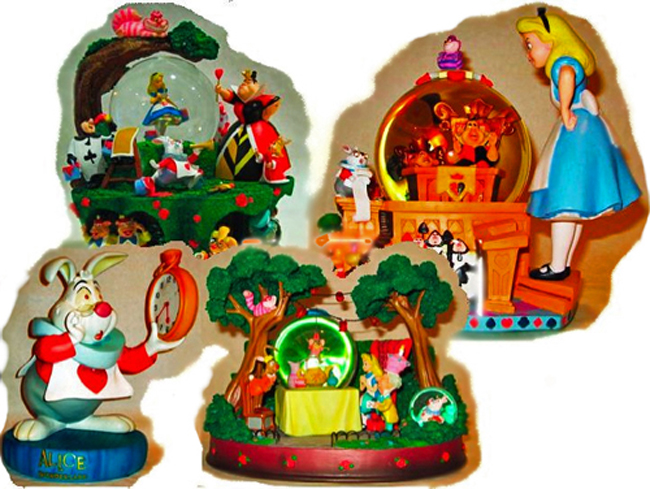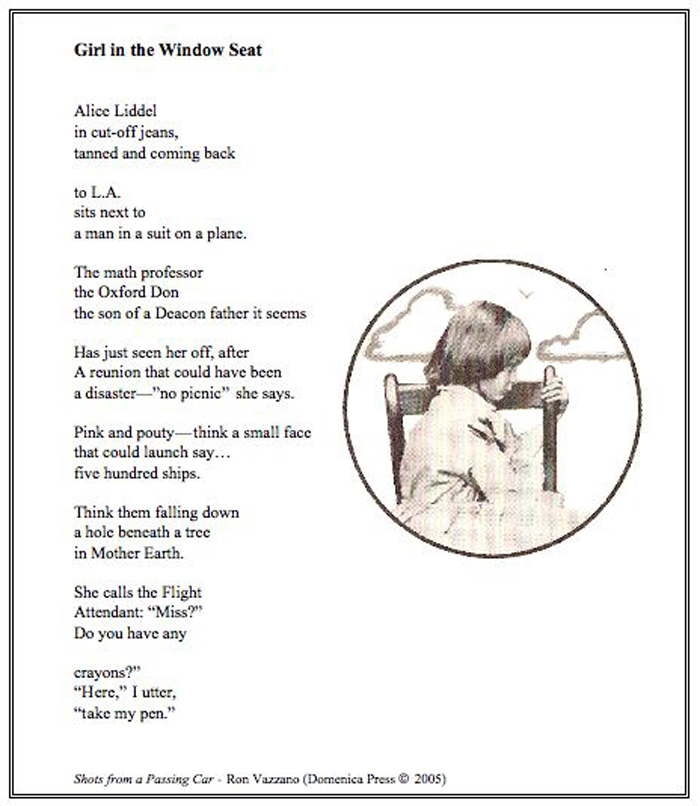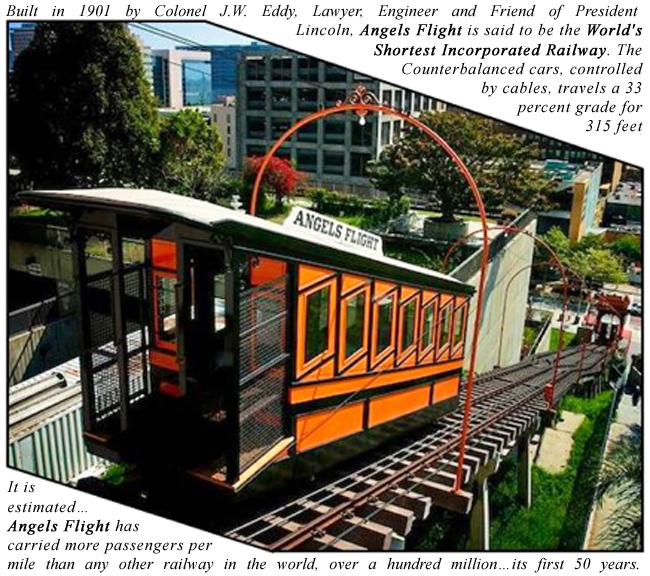April 2010
Disney in Wonderland
We have always been fans of Alice in Wonderland. It started with our first exposure to the Disney animated version in 1951, which it turns out, Disney himself hated. According to the wonderful biography written by Neal Gabler (Walt Disney: The Triumph of the American Imagination) he was heard to say: “…Alice was cold, you couldn't get any warmth into her…got trapped into making ‘Alice in Wonderland' against my better judgment…it's terribly tough to transfer whimsy to the screen.”
To this last comment we offer a resounding WHAT? Disney thinks it's tough to do whimsy? That remark, so incongruously coming from Walt's mouth, could itself be a piece of dialogue right out of that tea party. (“Tea party”, of course, having taken on some wild connotations these days— speaking of “Wonderland”— but we digress.) Anyway, we loved the film as a kid. And as an adult, we have always been drawn to its artistic execution, to which some of our “Alice collectibles” might attest:

But that was then and this is now. And now often is about going back and clarifying then. Now is about rewriting the narrative. Now is about sequels. Now is often about wondering … what if? And so the Disney studios decided to go back down that hole, pulled by the gravity of Tim Burton's vision.
In that vision, Alice has since moved on. A premise that enthralls us as well, as evidenced by a short poem we wrote many years ago. We reprise it here along with a stunning shot of the real Alice taken by the real Lewis Carroll—Charles Dodgson— a piece of work in his own right.

Meanwhile, if ever a movie cried out for a remake—what with the magic of the new technologies…what with the silver screen having been replaced in Hollywood by the “green screen,” in which actors act now and the set is filled in later … what with the return of 3D— it is Alice in Wonderland . In spades. (Or hearts?) And in this regard, Tim Burton doesn't disappoint. What he does do, is beg, borrow and steal from other movies and works all over the lot. But he does it well.
Here's what came jumping out at us in the course of the hour and forty minutes: Wizard of Oz, 101 Dalmatians (or was it Lady and the Tramp?) Harry Potter, St. George and the Dragon, The Prince (Machiavelli's book), a touch of Fantasia, Joan of Arc and even West Side Story (spoiler alert: at the end when the two warring armies lay down their weapons and realize that there's no longer a reason to fight). And as a sidebar to something we also found compelling—though we're not sure if Burton intended it this way—is the suggestion of a battle between “High Brow” and “Low Brow,” as personified by white chess pieces in combat with red playing cards.
And of course, as always, Johnny Depp. Here he adds still one more flamboyant role to his list of fantastical credits. In our estimation, it is a nicely nuanced performance—a Mad Hatter tempered with an intelligence, vulnerability and wit.
We suspect that the key to our enjoyment of this movie, has to do with not having been oversaturated by Burton and Depp over the years. They have now collaborated on seven movies; we've seen only one or two. And so what for others might have been a “here we go again” (the movie got mixed reviews despite grossing a fortune), was still something fresh for us. And while Burton has been criticized for not being very good with narrative, he did do what Walt and his people couldn't: put some life into Alice. In this iteration, she is finally not just “playing straight man to a cast of screw ball comics,” as described back in the day by a head Disney writer, Bob Carr.
What would Walt have thought about all of this? From what we've read, he was always trying to push the envelope. He probably would have admired the sparks of brilliance of Tim Burton. Ironically, Burton's Nightmare Before Christmas was based on a poem he wrote, while working as a Disney animator in the early 1980's. ( Or so the story goes). And one can only wonder what Walt might have wrought, given the tools of the new millennium. No doubt he would have invented a few himself. Though given to nostalgia, he was also a big believer in that was then and this is now.
Picture a Palindrome
Ever taken with palindromes, and having now revisited the rabbit hole, we offer...

A MALL LLAMA

While tossing and turning on a recent night heading into morning, we began to think about April approaching.
April Fool's Day. (When did that tomfoolery begin? Tomfoolery?) Easter. (With its Proustian remembrances of colored eggs past.) Opening Day at Yankee Stadium. (Can't wait.) Gotta' get the taxes done! (#$%&) And then suddenly— the tune April in Paris came into our head. Unrelenting and “lyricless,” save for the first line and title, and then something about, whom can I run to. And it would not leave.
Over and over. April in Paris…whom can I run to … and then the bridge, which we could not cross when we came to it: dah, dada, dah, dah, dah-dah-dah. Dah, dada, dah dah-dah…. April in Paris…whom can I run to. There would be no more sleep on this night— now morning. So we headed over to our desk and began to “Google” as if possessed.
We learned quickly that E.Y. (“Yip”) Harburg wrote it in 1932 for a Broadway musical called Walk a Little Faster. In 1952, they would make an April in Paris movie starring Doris Day and Ray Bolger. But aside from the use of his song, old Yip had nothing to do with that schmaltzy flick. His movie fame had come from The Wizard of Oz for which he wrote all the lyrics and got an Oscar for best song, Over the Rainbow. Yip would later be a victim of the Hollywood blacklist and that was it for his movie career.
We finally found our way to the lyrics.
They are so simple and sublime, that now daydreams of an April in Paris, begin to dance dans notre tête. While we've been there a few times in our life, it was never April. And so we Googled on, to perhaps capture some virtual sense of what that experience might be like. What we found was that, while April in Paris can truly be a romantic experience, the weather can be tricky as one website was far too thorough in pointing out. Reality always seems to find a way of putting a damper on things; raining, as it were, on our charade.
What follows are those illusive Yip Harburg lyrics, alongside words extracted verbatim from “About.com,” with their handy, yet daunting tips on How to Pack for a Trip to Paris in April. There is shall we say, a slight dissonance.
April in Paris
| |
April in Paris |
Paris is well known |
| |
Chestnuts in blossoms |
For its erratic |
| |
Holiday tables |
And sudden downpours. |
| |
Under the trees. |
An um-brell-a |
| |
April in Paris |
That can withstand |
| |
This is a feeling |
Strong rain and wind |
| |
No one can ever |
Is definitely |
| |
Reprieve |
A must. |
| |
|
|
| |
I never knew the charm of spring |
April is usually a wet month; |
| |
Never met it face to face |
Sloshy shoes and cold wet socks. |
| |
I never knew my heart could sing |
Make sure to pack a sturdy pair |
| |
Never missed a warm embrace |
Of waterproof shoes. |
| |
|
|
| |
‘Til April in Paris |
Unusually cold day |
| |
Whom can I run to |
Unusually hot day |
| |
What have you done to |
Can sneak up on you… |
| |
My heart… |
A hat… |
Lighthouse Sonnet
Inside my empty bottle I was constructing a lighthouse
While all others were making ships.
— Theodore Roethke

In days gone by who has not built a ship
Cut from the wood of a backyard tree
Absent direction but bent on a trip
Through white-capped waters of identity?
The ship itself is all that is ingrained.
Lack of direction ends in errant sights.
Intoxication at the siren's refrain,
Blinds us to jetties on moonless nights.
The depths of the sea are littered with grief—
The ersatz pirates who dealt in blank prose,
Nearsighted ones who never saw the reef.
But not of prophets and poets and those
Who would dare to think inside the bottle
And avoid the rocks while going full throttle.
—Ron Vazzano
Taking “ Flight” Once Again
Given its size, Los Angeles has relatively few signature landmarks that readily come to mind. Yes, there's the Hollywood sign. (Which itself could use some creative embellishment in our humble opinion). But the associations made with LA, usually begin with sunny weather and end with the movie industry. Hence the frequently applied pejorative— “La La Land.” That is, when it's not being called “Tinseltown.”
Those who love cities with a rich history, structure, lots of nuance and especially endearing quirks, have to make concerted efforts to find that here. So we were pleased to hear that Angels Flight had finally reopened last month. March 15th to be exact. So frequently has it been inoperable, that we thought of entitling this piece, “The Little Engine That Could, But Often Didn't.” Some history here is in order.
As taken directly from the commemorative plaque mounted at its site on November 1952 by the Native Daughters of the Golden West, for its 50th anniversary:

The problem is that in the many years that followed—throughout a full third of its existence—it didn't even travel an inch, let alone those mere 315 feet. (Which for the record, take all of 58 seconds to traverse). It was closed in 1969 for almost 30 years, while a new site was being developed. And then in 2001, after re-running for only five years, it was closed again following a fatal accident. And it stood that way for almost a decade until last month.
The ride we took in an original 1901 car— though quaint in its old-world low tech woodiness and bumpiness— was uneventful. And we don't wish to overstate the value that such a small venue, literally, can bring to a city. But such are the things that inject a little character and soul into a place. And it's interesting to note that while coming to this Bunker Hill district for our ride, we also wound up paying a visit to the Museum of Contemporary Art (MOCA), the Frank Gehry designed Disney Concert Hall (at which we picked up a great piece of original art work in the gift shop) and then the Ahmanson Theater area for a bite. All within easy walking distance.
It took a little train to get us out of the car and on our feet. And in so doing, helped to disprove once again, the old cliché about LA: that it is less a city than a state of mind; that there is no there there.
Now if only we could bring back the Pacific Electric “Red Cars” and the Los Angeles Railway “Yellow Cars” —two trolley systems that ran in LA until the “alleged General Motors Streetcar Scandal” shut them down by mid twentieth century. But that is a story for another day.
fini |
